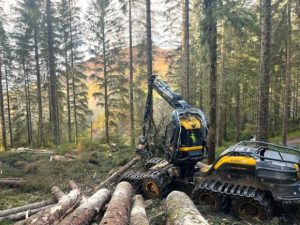
Arlington Real Estate and Homes England Submit Plans for £400m West Hartford Park Employment Hub
A major planning application has been lodged for West Hartford Park, a 126-acre industrial and commercial scheme near Cramlington that could deliver more than one million square feet of employment space and create around 2,000 jobs in Northumberland. The outline masterplan has been submitted jointly by Arlington Real Estate and Homes England, marking a significant step forward for one of the largest strategic development opportunities in the region. Located just minutes from the deep-sea Port of Blyth, the proposed development is designed to support the port’s continued expansion and forms a key component of the Energy Central Partnership. This initiative positions South East Northumberland as a national centre for offshore and renewable energy, clean technology, advanced manufacturing and AI-driven industries. The Port of Blyth, home to ORE Catapult’s world-leading testing facilities, is working closely with Arlington Real Estate and Homes England to maximise the economic potential of the scheme and attract major occupiers from both the UK and overseas. Despite the marketing campaign not yet being launched, the project has already generated strong interest from several large-scale industrial and logistics businesses. If approved, West Hartford Park is expected to generate over £400m of investment for the North East economy and deliver thousands of high-quality jobs, providing a major boost to local supply chains and long-term regional growth. Dean Cook, managing director of Arlington Real Estate, said submitting the application marks an important milestone in unlocking the site’s full potential. He highlighted that West Hartford Park is the only location in the region capable of accommodating development at this scale, offering the power, infrastructure and connectivity required by major occupiers. Cook added that the project will directly support the growth of offshore and renewable energy, advanced manufacturing, logistics and AI sectors. Councillor Richard Wearmouth, deputy leader of Northumberland County Council and cabinet member for business, growth and regeneration, welcomed the news, describing West Hartford Park as the county’s most significant remaining employment allocation in the current local plan. He said maximising its potential is crucial to attracting future investment and creating new job opportunities in the area. Martin Lawlor OBE, chief executive of the Port of Blyth, added that the partnership approach will help bring forward much-needed capacity for port-related development while acting as a catalyst for broader economic growth across the region. The submission of the planning application marks the start of the next phase in bringing West Hartford Park to fruition, with the scheme set to play a central role in strengthening Northumberland’s position within the UK’s energy and advanced manufacturing landscape. Building, Design & Construction Magazine | The Choice of Industry Professionals

Property Trust Group and Staycity Start Work with Gilbert Ash on £120m Wilde Aparthotel in Shoreditch
Construction has officially begun on a £120m Wilde aparthotel in Shoreditch, as Gilbert Ash breaks ground on the major London development for Dublin-based Staycity Group and The Property Trust Group. Located at 19 Great Eastern Road, the 11-storey scheme is set to become Staycity’s largest Wilde-branded property in the capital and its fifth within Zone 1. WT Partnership is acting as project manager, with completion scheduled for May 2027. The new aparthotel will provide 275 studio and one-bedroom units, each designed with self-catering layouts to support longer stays and flexibility for guests. The development will also feature an extensive range of amenities including a restaurant, café-bar and cocktail lounge, communal dining areas, a fitness room and a guest laundry. A biodiverse roof will crown the building, contributing environmental benefits and supporting local ecology. The Wilde brand, inspired by the spirit and style of Oscar Wilde, debuted in Covent Garden in 2018 and has since expanded across major European cities including Berlin, Cambridge, Edinburgh, Lisbon, London, Manchester and Vienna. Further openings in Amsterdam and Porto are already planned as the brand continues its rapid growth. The Shoreditch project marks another significant step in Staycity’s ambition to expand its presence across key urban centres, while reinforcing The Property Trust Group’s commitment to delivering high-quality hospitality developments in prime city locations. Building, Design & Construction Magazine | The Choice of Industry Professionals

Project starts uptick brings some festive cheer to UK construction
Glenigan Review sees UK construction activity slowly reasserting itself as the year draws to a close. Today, Glenigan | Powered by Hubexo (Glenigan), one of the construction industry’s leading insight and intelligence experts, releases the December 2025 edition of its Construction Review. The Review focuses on the three months to the end of November 2025, covering all major (>£100m) and underlying (<£100m) projects, with all underlying figures seasonally adjusted. It’s a report providing a detailed and comprehensive analysis of year-on-year construction data, giving built environment professionals a unique insight into sector performance over the past year. Moving (slowly) in the right direction The December Review indicates that UK construction is starting to take slow steps along the road to recovery, reflecting predictions Glenigan recently made in its latest industry Forecast. Despite starting out from a lower position than December 2024, with project start performance considerably down (-29%), a 14% increase compared to the previous three months to the end of November will provide some festive cheer to counter any new year fears. The news will come as a relief to contractors and subcontractors alike, following a torrid six months punctuated by policy flip-flopping and a case of acute socio-economic hiccups. This small glimmer of hope should be approached with cautious optimism as elsewhere the project pipeline remains considerably dry. Main contract awards fell by a quarter (-26%) year-on-year and dropped by 10% during the Review Period. Similarly, detailed planning approvals were down by 9% against the preceding three months and by 26% compared with 2024 figures. According to Glenigan’s Economics Director, Allan Wilen, “The currently tempestuous economic conditions are making it difficult for the construction sector to get out of first gear, where it seems to have been stuck throughout the second half of 2025. Hopefully the Chancellor’s recent Budget Statement will have gone some way to providing clarity around future funding, ending a period of weathervane politics in which potential property and tax policies were floated across the market, denting both consumer and private investor confidence. Now we know the intended direction of travel, hopefully the industry can get back on track.” He continues, “However, it’s not going to be an easy task, requiring a considerable amount of work commencing, contracts awarded, and planning approvals rubber-stamped before the end of this financial year if our predicted recovery is going to come to fruition. In the here and now though, this revival probably seems far on the horizon with performance remaining depressed. A modest lift in starts activity over the Review Period has been largely driven by an extraordinary surge in underlying office construction. Elsewhere, minimum wage increases are driving up retailing and hospitality labour costs. This has led to pauses and delays as businesses look to rebalance budgets and re-evaluate resources, deterring investment in retail and hotel & leisure projects. As we look ahead to Q.1 2026, the Chancellor will need to make good on her £120 billion infrastructure pledge, putting the pedal to the metal to get the sector motoring once more.” Taking a closer look at some of the Review highlights… Let’s hear it for the office outliers In a bleak midwinter for most of the industry, the offices vertical has basked in the warming afterburn of skyrocketing performance. Activity is incredibly healthy with a 161% increase in project starts, as well as a 60% rise in detailed planning approvals year-on-year. This growth can be attributed to a number of different factors, including the insatiable demand for data centres (grouped within the office vertical), responding to consumer and businesses’ ravenous appetite for digital technology and a growing reliance on AI. Regionally, the East Midlands, London, the North East and the South East experienced a strong period of growth. The Capital posted the highest share of project starts during the Review Period (+80%), largely thanks to a 184% starts increase boosted by the £800 million Project Vista Development in Lambeth. Wales was responsible for the impressive leap in planning approvals, with the value of consents jumping more than 40 times year-on-year. This was predominantly the result of the green light being given to a £5 billion CWL41 data centre development in Bridgend. A growing sense of community The community and amenity vertical also experienced an exceptionally robust Review Period, with project starts and main contract awards up year-on-year and quarter-on-quarter to boot. That wasn’t all, detailed planning approvals grew in the preceding three months and were only 1% lower than 2024 figures. Major projects had a relatively sunny season with increases recorded across all three contract stages compared to last year and the previous three months. This growth spurt was mainly driven by a 198% year-on-year growth in the prisons sub-category, particularly the £713 million HMP Welland Oaks in Leicestershire. Unsurprisingly, this also meant that, regionally, the East Midlands accounted for the highest share of project starts in this vertical. London and the South East also showed impressive scores, once again spurred by penal facilities development, especially the £300 million HMP Grendon Underwood development in Aylesbury. Preparing for a civils ceremony Whilst civils experienced significant declines in main contract awards during the Review Period (-64%) compared to the prior three months, with the value of detailed planning approvals slashed in half compared to last year (-50%), it witnessed a major boost in project starts (up 118% against the preceding three months). The 2025 Autumn Budget provided a much-anticipated shot in the arm for civil engineering, with expanded regional infrastructure and accelerated transport investment earmarked by the Chancellor. The devolved £13 billion for the metro mayors will be welcomed across all quarters of the vertical, alongside more capital allocation for highways maintenance. This will likely strengthen activity for local road, transport, and utility projects, sparking the future growth Glenigan has predicted in 2026 and 2027. Roads, energy, and harbour/ports accounted for the lion’s share of activity, with performance in the latter up a dizzying 267% year-on-year. Regionally, the East of England was the most active, project-starts wise. London

Railpen Secures Secretary of State Approval for £1bn Cambridge Beehive Innovation Park
Railpen has received a major boost for its ambition to transform the Beehive site in Cambridge, after the Secretary of State for Housing, Communities and Local Government, the Rt Hon Steve Reed OBE, approved its plans for a 1 million sq ft mixed-use, lab-led innovation district. Currently operating as a retail park, the Beehive site will be reimagined as a world-class research and technology hub. Railpen’s proposals include flexible workspace for science and technology companies, high-specification laboratories, a new community park, a youth and community hub, a science centre, and around 20 new shops, cafés and restaurants. The scheme places strong emphasis on accessibility and sustainability, supported by significant public transport upgrades designed to remove more than 10,000 car journeys from local roads. Railpen has said the development will deliver substantial economic benefits to Cambridge and the wider region, including a projected £600m uplift in gross value added, increased tax revenues, and expanded employment opportunities. The decision also enables improvements to the neighbouring Cambridge Retail Park, where Railpen has already begun a programme of upgrades intended to enhance the experience for retailers and visitors. The first phase has recently completed with the opening of a new Starbucks. Andy Bord, chief executive officer of Railpen, welcomed the Secretary of State’s decision, describing it as a recognition of the merits and appropriateness of the Beehive proposals. He noted that the approval represents a major milestone for the Oxford-Cambridge Growth Corridor and reflects sustained international confidence in the UK’s business environment. Bord said Railpen remains committed to delivering its Innovation Cluster vision in Cambridge and will continue to work closely with local partners to ensure the scheme contributes meaningfully to the city’s long-term economic and social prosperity. The Beehive development forms part of Railpen’s wider Innovation Cluster in Cambridge, a portfolio of 11 assets totalling 1.9 million sq ft and designed to meet evolving occupier demands across life sciences, technology and research sectors. Other assets in the cluster include the recently consented 230 Newmarket Road; Mill Yard, a 180,000 sq ft mixed-use campus completing in Q1 2027; Botanic Place, a 325,000 sq ft headquarters development due in Q1 2028; and Railpen’s proposed 112,000 sq ft Grade A office building. With central government backing now secured, Railpen’s Beehive scheme is set to play a significant role in shaping the next phase of Cambridge’s innovation landscape. Building, Design & Construction Magazine | The Choice of Industry Professionals

A year of recognition for Forestry and Land Scotland with award wins
Forestry and Land Scotland (FLS) and its staff have been recognised with multiple awards in 2025 marking the organisation’s professionalism, forest management, technical expertise, innovation and training. At the recent Scotland’s Finest Woods Awards 2025 – highlighting the best management of woods and forests across Scotland – FLS picked up several awards. The organisation was announced as the winner of the award for a Single Stand, Compartment or Small Wood and the Hunter Blair Trophy for Silvicultural Excellence for its Braeval Forest at Aberfoyle. The work at the forest was carried out by the Direct Production Harvesting Team in Aberfoyle and was a continues cover thinning site which focuses on maintaining canopy cover while creating small gaps to promote natural regeneration. This method enhances timber quality, supports wildlife habitats, and improves structural diversity, contributing to recreational appeal and public use. FLS also shared the Woodland Trust Scotland Trophy for New Native Woods with partner agency Transport Scotland for Rest and Be Thankful in Argyll. More than 400000 native trees with a range of species have been planted to maximise slope stability. This will complement the hard engineering and bring other benefits such as improved water quality and biodiversity. The work of FLS Community Rangers was celebrated as part of a win for West Johnstone Early Learning and Childcare Centre’s outdoor education programme also at Scotland Finest Woods Awards 2025. The FLS team worked with the group to help demonstrate the importance of urban woodlands to local communities. Earlier this year, FLS apprentices triumphed at the Lantra Scotland Awards for Land Based and Aquaculture skills. All four FLS apprentices that were in contention for awards – held during Scottish Apprenticeship Week – were recognised as either winners or runners-up in a variety of categories. Other highlights included several awards for Newton Nursery’s groundbreaking redevelopment. These included UK Project of the Year at the Commissioning Specialists Association (CSA) Gala Awards. The award recognised the transformation of the nursery into the largest and most advanced tree-growing glasshouse in the UK. It also championed the exceptional technical achievement and sustainability credentials required to develop such a major contribution to Scotland’s forestry industry, rural communities and climate ambitions. The nursery redevelopment also won the Project and Programme Management Award at the 2025 Scottish Public Services Awards. FLS’ renewables and regional land management teams played a significant role in North Kyle Wind Farm’s recent success at the Scottish Green Energy Awards 2025. The Sustainable Development Award honoured the collaborative work between land managers and the developer to deliver environmental, social and economic benefits through repurposing a former coalfield area into a thriving landscape for clean energy generation, community benefit, and sustainable growth. FLS Director of Land Management and Regions Graeme Prest said: “The range of awards received by FLS is an acknowledgement of the skills, expertise, dedication and commitment of FLS staff and the qualities they bring to the organisation. “From producing high-value sustainable timber, harnessing the benefits of trees and other habitats to mitigate against climate change and biodiversity loss, being at the forefront of innovation and facilitating renewable energy to training the next generation of foresters, FLS and its staff are leaders in professional and industry standards.” Building, Design & Construction Magazine | The Choice of Industry Professionals

HS2 cuts traffic delays with innovative M6 bridge slide
Engineers working for the HS2 project claimed a UK-first over the weekend when they successfully slid an enormous 4,600-tonne viaduct across the M6 without closing the motorway – significantly reducing disruption to drivers. The 17 hour-long operation was the culmination of an epic three-stage process to assemble and install the 315-metre East deck of the M6 South viaduct, which will carry high-speed trains heading to Birmingham and further north. While the previous slide had required a weekend closure of the main carriageway, the team – led by HS2’s main work contractor Balfour Beatty VINCI (BBV) – worked closely with National Highways to develop the ‘fully restrained’ process which allowed them to safely slide the final section above the moving traffic. It is thought to be the first time this technique has been used on a UK motorway. To deliver this, they initially closed the M6 overnight between Junctions 4 and 5 on Thursday 11 December to shift the viaduct slightly forward by twelve metres. This was to ensure that both ends of the enormous beam were fully supported on concrete piers during this weekend’s slide. The viaduct was then pushed the rest of the way across the busy motorway on Saturday at a speed of 13 metres per hour, with only the M42 slip closed during the weekend. The successful operation means the project to construct the M6 South viaduct has reached the halfway point. Over the next year, the same process will be repeated, with a parallel West deck slid into position alongside the first one to carry trains heading south. Caroline Warrington, HS2 Ltd’s Head of Delivery, said: “Along the HS2 route we are pioneering new approaches to engineering and construction in order to deliver more efficiently and with less impact on our neighbours. “We believe this fully restrained slide was a first for the country, but most importantly it means we’ve been able to cut in half the number of times we’ve had to close the motorway. I’d like to thank everyone who worked so hard to make the operation a success.” Mark Wild, HS2 Ltd’s Chief Executive, is currently leading a comprehensive reset of the programme – making sure the new railway is built as efficiently as possible and for the lowest reasonable cost. Over the last year, HS2 has focused on safely boosting levels of productivity across the construction programme. The M6 South viaduct has been designed in stages to increase efficiency and reduce disruption for motorists. Each section is assembled to one side before being pushed out over the motorway, with the next section added behind it. In the latest phase, the team moved the viaduct using a series of winches, known as strand jacks. To reduce friction, the structure was slid across non-stick pads, using a material usually found on the surface of a household frying pan. Russell Luckhurst, the BBV engineer leading the delivery of the works, said: “We’re all feeling a huge sense of pride after sliding a 4,600-tonne viaduct into its final position this weekend. The third and final slide of the East deck viaduct was delivered over a live motorway for the first time in the UK, making this achievement even more special. “Using this ‘fully restrained’ technique meant we were able to keep disruption to an absolute minimum. Our focus will now turn towards the neighbouring West deck viaduct, which will be launched in multiple phases throughout 2026, as well as the East deck finishing works.” Each viaduct is formed of a hollow double-box structure made of weathering steel. The steel boasts a natural protective layer of oxidisation which gives it a characteristic ‘rusty’ appearance and reduces maintenance by eliminating the need for regular repainting. Four pairs of concrete piers support the viaducts with the tallest one measuring 9.9m in height. A 4.5-metre-high parapet will be installed on the side facing Chelmsley Wood to reduce noise and disturbance from passing trains. The viaduct was launched with 82 precast slabs already installed on top of the steel structure. This will further reduce the number of road closures in the future, to complete the viaduct deck works. The structural design has been carried out by Balfour Beatty VINCI’s Design Joint Venture (DJV), made up of Mott MacDonald and SYSTRA, plus WW+P Architects. National Highways Regional Director for the Midlands, Victoria Lazenby, said: “Our key focus is the impact that these major construction works have on our roads – we must both ensure the safety of road users and minimise the disruption they face. “So we are delighted that this innovative technique has meant that not only was this enormous structure slid into place without having to close the motorway during the day but also that the total number of closures needed has also been halved.“We will continue to work with HS2 and their partners to ensure the smooth running of our roads while this huge infrastructure project takes place and support any initiatives which will reduce disruption for drivers and local communities.” Building, Design & Construction Magazine | The Choice of Industry Professionals

